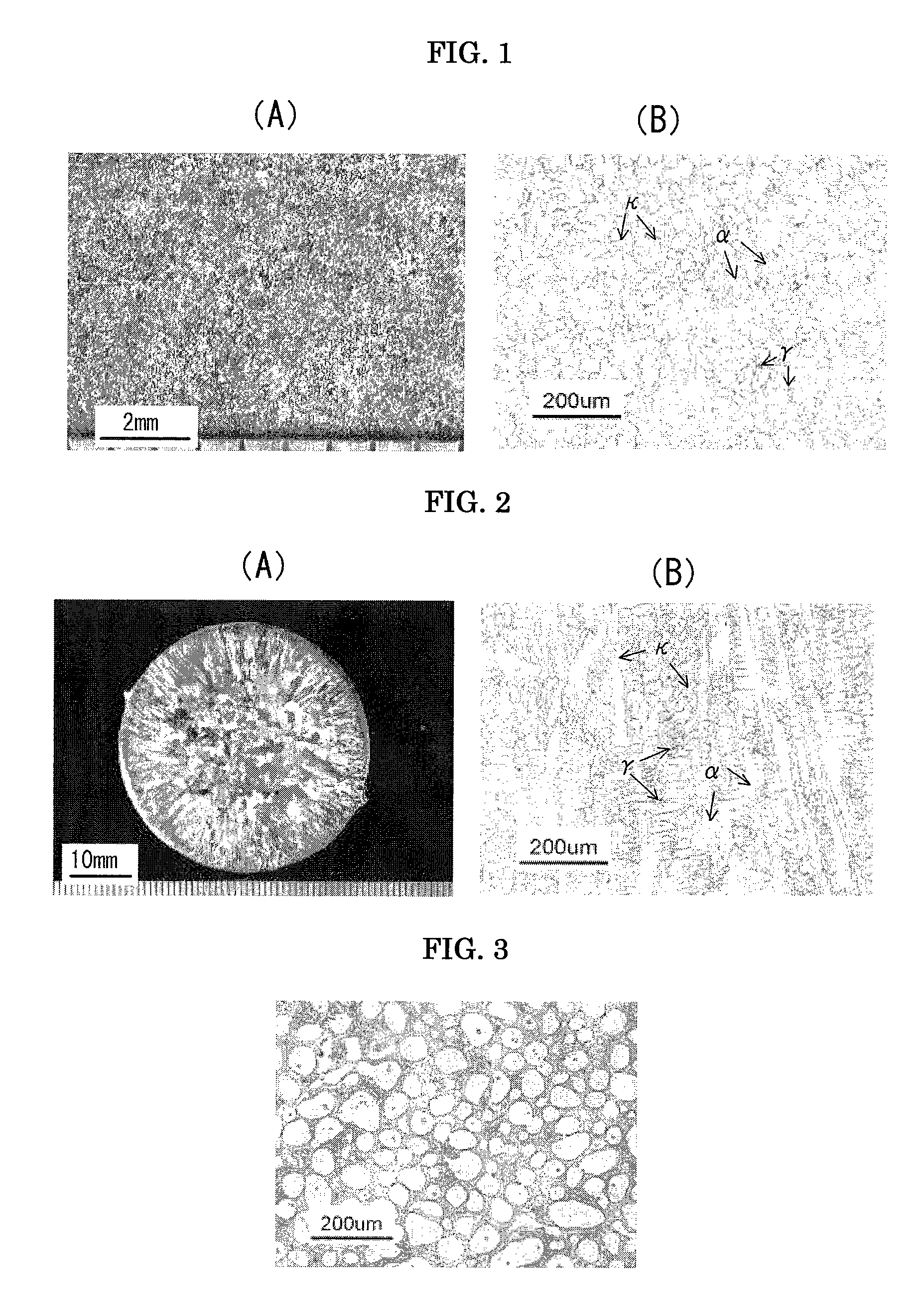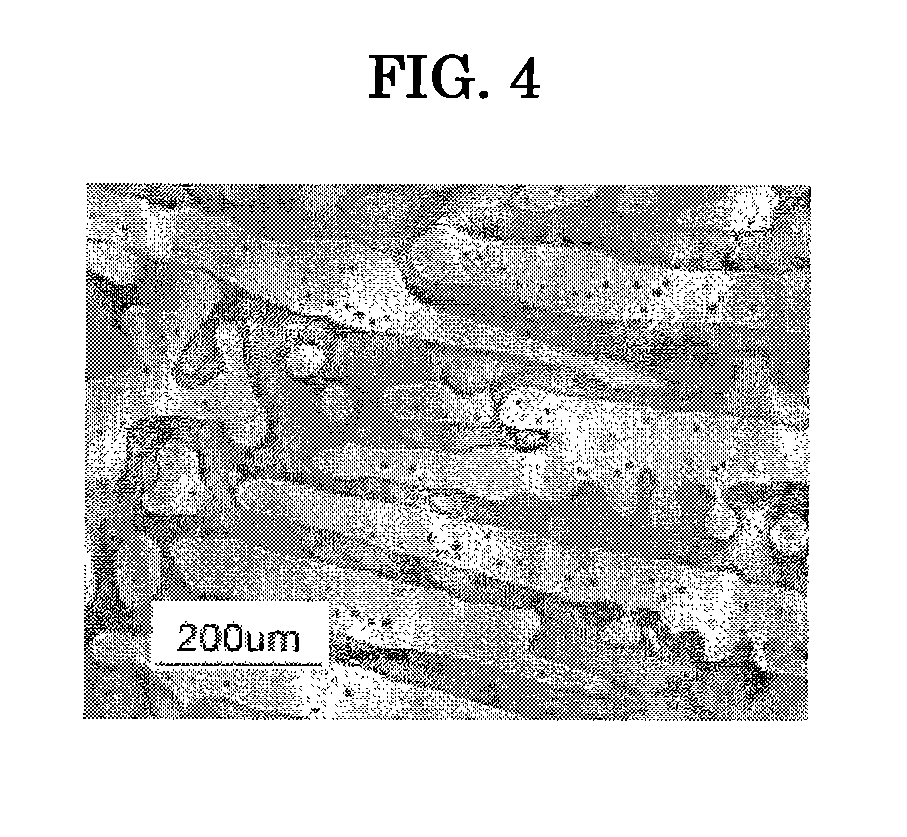However, in the case of (A), since the grain refinement effect of Zr in the step of melt-solidification is considerably influenced by other elements and their contents, a desired level of grain refinement is not achieved.
However, as in the technique of (B), these treatment and working after
casting for refining the grain
diameter result in increased costs.
Further, some castings can not be subjected to the deformation
processing for
distortion addition due to their shapes.
Hence, although the content of Zr is increased, the grain refinement corresponding to the increase is not necessarily achieved.
Accordingly, when being melted and added in the
atmosphere, Zr easily forms an
oxide and is very low in yield.
As such, although a very small quantity of Zr is contained in products after
casting, it is required to charge a considerable quantity of
raw material in the step of
casting.
Meanwhile, when being too much produced during melting, the
oxide is easily entangled when casting, there is a chance to generate casting defects.
In order to avoid production of the
oxide, the melting and casting may be carried out under a vacuum or
inert gas
atmosphere, which causes increase of costs.
Further, in the case of the Cu—Zn—Si based alloy, Si serves to improve
mechanical property etc., but during melt-solidification, has problems that it is easy to generate a crack or
porosity, that a shrinkage cavity is great, and that it is easy to generate casting defects such as a blow hole.
Arms of the
dendrite make it difficult to
discharge generated air bubbles into the air, which is responsible for residual of blow holes, and local generation of great shrinkage cavity.
However, when the content of Cu exceeds 88 mass %, strength and
wear resistance are deteriorated, so that there is a chance of hindering a grain refinement effect by co-addition of Zr and P as described below.
However, even when Si is added above 5%, grain refinement caused by co-addition with Cu and Zn is saturated or deteriorated in reverse, and furthermore causes deterioration of
ductility.
Further, when the content of Si exceeds 5%,
thermal conductivity is deteriorated and a solidification temperature range is widened, so that there is a chance of deteriorating
castability.
When Zr is excessively added,
viscosity of the
molten metal is increased to cause casting defects by inclusion of the oxide and
sulfide during casting, so that it is easy to generate the blow hole or micro
porosity.
In this case, versatility disappears, and costs are considerably increased in the
copper alloy where Zr is merely added as the refinement element.
P has important relation with Zr, but is not favorable in that even when it is added in excess of 0.25 mass %, the refinement effect is small, and rather the
ductility is damaged.
Specifically, in a rapid cooling where the
cooling rate has an order of 105° C. / sec or more, there is no time to perform
nucleation of the
crystal, so that there is a chance that the grain is not refined.
Further, approach to the equilibrium state causes the composition range taking part in the peritectic reaction to become narrow.
Further, Pb and Bi mainly exist at a
grain boundary in the melted state after solidification, so that when their particles are increased, it is easy to generate a hot crack.
In regard to ductility at a
room temperature, the stress is concentrated on the particles of Pb and Bi, so that the ductility is damaged (It goes without saying that when the grain is large, the ductility is geometrically damaged).
However, although Sn, As and Sb are added in excess of a certain amount, it is impossible to obtain an effect suitable for the addition amount, and ductility is rather deteriorated.
Thereby, there is a chance that an effective grain refinement function by Zr is lost.
Further, the melt fluidity is deteriorated, and thus it is easy to generate casting defects such as a blow hole, crack and so forth.
Furthermore, when a large quantity of
oxygen exists in the
molten metal, there is a chance that Zr forms an oxide and thus the refinement function of the grain is lost.
However, when Mg is added in excess of 0.2 mass %, Mg is subjected to oxidation like Zr, and the
molten metal is increased in
viscosity, and there is a chance of generating casting defects by, for example, inclusion of the oxide.
When the grain is not refined, the heat treatment is required several times for the purpose of removing the
dendrite structure characteristic of the casting or facilitating division,
subdivision of the K phase and the γ phase, and its surface state becomes bad because the grain is coarsened.
In other words, when the K phase and the γ phase are not uniformly distributed, a strength difference from the a phase of the matrix easily generates a crack and damages ductility at a
room temperature.
Further, since particles of Pb or Bi exist at a boundary with the α phase or at a
grain boundary, a large-size phase easily generates a solidification crack and damages the ductility at the
room temperature.
However, in the case where the
scrap material is a
nickel plating material or the like, when Fe and / or Ni are contained as the inevitable impurities, it is necessary to
restrict their contents.
For instance, this is because, although Zr and P are excessively added, there is a problem of hindering the refinement action of the grain.
In other words, when the
solid phase in the semi-melted state begins to form a network of the
dendrite, the melt including the
solid phase is difficult to spread to all the corners.
In this respect, the
formability by casting is deteriorated, and thus it is difficult to obtain the casting having the high precision or complicated shape.
 Login to View More
Login to View More 


